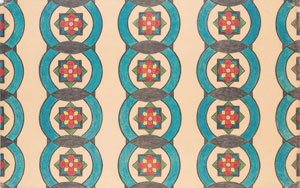11.25.24 — New York with Reservations
Mary Sully took the long view. It did not settle anything, but it did bring a kind of peace.
The Met calls a selection of two dozen drawings “Native Modern,” through January 12, and she was equally at ease with Native American craft, Modernism, and her own rebellious spirit. She herself called them “/personality prints,” and they depict no end of other personalities as well from stage and screen. She produced many indeed from the 1920s through the 1940s,  none of them dated. It is all she can do to encompass New York between the wars and her own mixed ancestry—and I bring this together with my recent report on Aboriginal Australian bark painting as a longer review with more of the long view as my latest upload.
none of them dated. It is all she can do to encompass New York between the wars and her own mixed ancestry—and I bring this together with my recent report on Aboriginal Australian bark painting as a longer review with more of the long view as my latest upload.
Each drawing has three parts, stacked vertically, for another kind of long view. Coming to Sully amid indigenous art in the Met’s American wing, one might dismiss her work as more of the same. Her vertical format and obsessive patterning recall traditional blankets and dresses, and the museum throws in one of each for good measure. She herself cultivated the image of the unknown, self-taught artist in America’s oldest Indian village. She appears on film, working away while dressed to the Native American nines. One can almost overlook the film’s producer, Paramount Pictures.
She knew her Dakota homeland, but she also knew New York, where her sister studied anthropology under Franz Boas at Columbia University. She celebrated Easter on Fifth Avenue and dedicated a drawing to Fiorello La Guardia, the New Deal mayor. She called another drawing Greed, lest there be any doubt that corporate interests brought on the Depression in the first place. In a drawing for Walter Winchell, the radio news anchor, Sully’s zigzag patterns could be bursts of radio waves, carrying the city’s message to the world. A drawing for Florenz Ziegfeld has at top a circle of pretty faces, right out of the Ziegfeld follies. Others allude to Alfred Lunt and Lynn Fontanne, the Broadway actors, but also a child actress, because sophistication is in the eye of the beholder.
Sully cultivated her family history, too, in all its amalgams and contradictions. Her father, Philip J. Deloria, was an Episcopal minister in a Native American church, and a drawing depicts a ceremony. It has a minister at its center in a proper prayer shawl, while curtains to either side might be officiants themselves and seem to take on wings. She took her name, though, from her mother, herself of mixed ancestry. The young artist could not have minded that it also marks her as the great-granddaughter of Thomas Sully, the painter born in England. She could not have minded, too, that his parents were actors and his portraits include composers along with Thomas Jefferson.
She was taking the long view, too, in a triptych for Three Stages of Indian History. The patterned lower third may adapt “Pre-Columbian Freedom,” while figures on the grass just above inhabit an idealized version of Standing Rock Reservation, her birthplace. That leaves the crowded silhouettes at top for “The Bewildering Present.” Unless, of course, their dark outlines derive from Pre-Columbian pottery—and the wild zigzags for upheavals in Native American and modern art. Oh, and did I say that Sully titles that sunlit expanse “Reservation Fetters”? Freedom may not come easily.
The curators, Patricia Marroquin Norby and Sylvia Yount, single out one drawing for its “unusual ambiguity,” but ambiguity for Sully comes with the territory. Elsewhere dark silhouettes could represent Depression-era labor, entertainers, or celebrants. The colorful patterns could derive from her ancestors or still-revolutionary abstract art. Often text appears at bottom, as a fourth panel, to identify the subject. One for Gertrude Stein quotes “rose is a rose is a rose is a rose.” Repetition like that could be naïve or revolutionary, too—and, of course, sheer patterning.
Not many artists back then were fluent in terms like “Pre-Columbian,” and not many had a linguistic ethnographer for a sister. And how many could turn colored pencil and pastel crayons into drawing with the precision of ink and a softness akin to watercolor? Sully is no closer to fame, but then she had reservations about fame, even as she pursued it. One last triptych has a cart at top overflowing with flowers, a floral tapestry, and then the zigzags. It could mark the passage from the streets of New York to the reservation and finally to abstraction. Or it could run the other way, from abstraction to nature.
Read more, now in a feature-length article on this site.